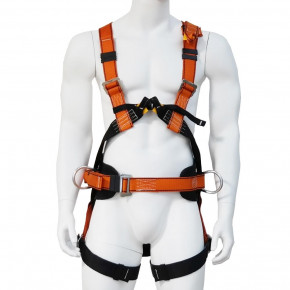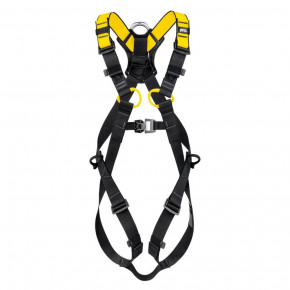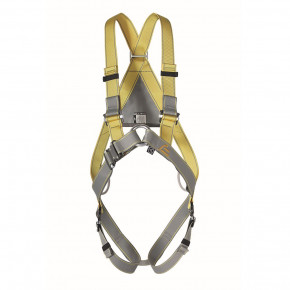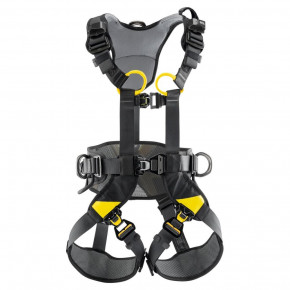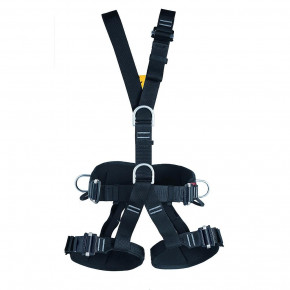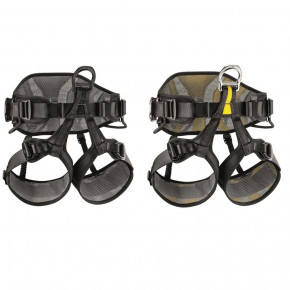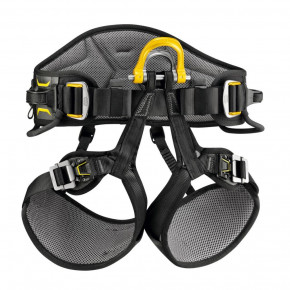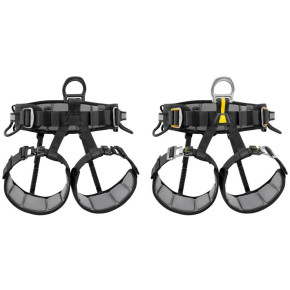Harnesses
This category includes the following types of harness: fall arrest, fall arrest PPE (personal protective equipment against falls from a height), work positioning, rope access (for rope access and positioning work), rope climbing (climbing trees using ropes), rigging, and rescue at height (special rescue work at height and depth).
Our range of products comprises the following types of harness:
Harnesses that protect the wearer from falling, featuring an attachment point on the chest (sternal) and/or at the rear (dorsal) compliant with standard EN 361, clearly marked with the letter “A” for “fall Arrest”. In the event of the wearer falling, the position of the attachment point ensures that the resulting impact is tolerable by the human body and distributed along the body’s axis, and that the body is suspended vertically after the fall is arrested. Fall arrest harnesses are available as conventional harnesses and as part of a system featuring a body vest that makes the harness much easier to use and the user more visible. Typical applications are in the building industry, such as for rooftop work and work from elevating work platforms.
Fall arrest and work positioning harnesses featuring an attachment point on the chest (sternal) and/or at the rear (dorsal) compliant with standard EN 361, clearly marked with the letter “A” for “fall Arrest”, plus two lateral attachment points compliant with standard EN 358 for attaching a fixed or adjustable work positioning system (also known as a restraint lanyard or positioning lanyard). If the user needs not only to be prevented from falling but also to temporarily adopt a certain position, for example when climbing pylons, antennas or metal structures during operations requiring the use of both hands, a harness of this type is the perfect choice. The comfortable, padded ergonomic dorsal support allows this harness to be used with a restraint lanyard for long periods.
Our suspension harnesses for difficult access work are versatile and comfortable industrial climbing harnesses designed for rope access and positioning techniques. Suitable for an extremely wide range of applications, they combine functions such as fall arrest in compliance with standard EN 361 with the work positioning functions required by standard EN 358. They also feature a low front attachment point that complies with EN 813 for rope access work. Chest ascenders for rope climbing can be attached to the harness subsequently or can be firmly sewn on as part of the harness. These harnesses generally feature an equipment loop for attaching additional equipment and tools; they can also be fitted with a seat. Many of these harnesses feature wide padding around the thighs, waist and shoulders, making them comfortable to wear for several hours. This type of harness is the perfect choice for working at great height and in areas that are difficult to access, such as for work, inspections, assembly of and repairs to wind turbines, church towers, the façades of high-rise buildings or stadium roofs, and also for work at depth such as wells or inspection shafts.
Our seat harnesses (also known as sit harnesses) feature a ventral attachment point for rope access, for attaching descenders compliant with standard EN 813 or for using mobile fall arresters compliant with standard EN 353-2. The lateral attachment points compliant with standard EN 358 can also be used with additional restraint and positioning lanyards. Seat harnesses can be used for rope suspension work, but wherever an uncontrolled fall cannot be ruled out, a fall arrest harness compliant with standard EN 361 must be used without exception. A seat harness combined with a compatible chest harness can be used to create a fall arrest harness compliant with standard EN 361. Our seat-harness-compatible chest harnesses with chest ascender can also be used for rope climbing.
When combined with a compatible chest harness, our specially designed seat harnesses and work positioning harnesses can be used as fall arrest harnesses compliant with standard EN 361. Depending on the equipment requirements, our seat-harness-compatible chest harnesses can also be fitted with an integrated chest ascender. The EXPERT range from Singing Rock® can be converted from a fall arrest harness to a work positioning seat harness by removing the detachable chest harness. With these 2-in-1 combination products, the user does not have to buy an additional harness for other applications.
Seat harnesses designed specifically for the requirements of tree-climbing techniques involving ropes in forestry work and arboriculture. These harnesses have lateral attachment points compliant with standard EN 358 and a special anchorage option compliant with standard EN 813 for optimum lateral mobility to make working in the outer branches of trees comfortable. Featuring extremely comfortable padding and a rigid dorsal section, these tree-climbing harnesses enable the user to carry out suspension work for several hours without tiring, and their large number of equipment loops generally offer sufficient options for attaching other equipment and tools.
Work positioning harnesses featuring two lateral attachment points compliant with standard EN 358 for attaching a fixed or adjustable work positioning system (also known as a restraint lanyard or positioning lanyard). A work positioning harness keeps the user away from the edge of an area where there is a risk of falling and also keeps them in position while working on a structure. However, wherever an uncontrolled fall cannot be ruled out, a fall arrest harness compliant with standard EN 361 must be used without exception.
In adventure parks and high- and low-level ropes courses, full body harnesses complying with the following standards are generally used: rock climbing harnesses compliant with standard EN 12277 type A (mountaineering and rock climbing equipment – full body harnesses); fall arrest harness compliant with standard EN 361 (fall arrest and work positioning harnesses). Our harnesses developed for adventure park use are available in a range of sizes indicated by different colours for easy distribution at hire venues. In addition, these harnesses are quick and easy to don and remove, and they can easily be adjusted by the wearer.
Special harnesses for various rescue situations and suspended rescues that enable search and rescue, first aid, and evacuation of casualties in emergency situations at height or at depth. These types of harnesses feature particularly low anchorage options. The Falcon range from Petzl®, for example, is specially designed for this use. Rescue harnesses compliant with standard EN 1497 are used exclusively in rescue situations and enable the casualty to be secured directly in a rescue system compliant with standard EN 363. For models that do not comply with standard EN 1497, the rescue harness can be used only to stabilise the body and not as the main component in a rescue system as per standard EN 363. If the casualty is already wearing a fall arrest harness that also complies with standard EN 1497, an additional rescue harness is not generally required for rescue operations.
Special harnesses and loops for rope rescue operations at height and depth where space is restricted. Rescue loops compliant with standard EN 1498 are devices designed to support the body and are a part of rescue systems. They are made up of straps, connectors and other elements designed and manufactured to enable the casualty to be held in a given position during the rescue operation.
Choose a product below:
from 129,90 €
incl. 19 % VAT plus shipping costs
from 102,15 €
incl. 19 % VAT plus shipping costs
from 127,69 €
incl. 19 % VAT plus shipping costs
from 122,58 €
incl. 19 % VAT plus shipping costs
from 148,12 €
incl. 19 % VAT plus shipping costs
from 158,33 €
incl. 19 % VAT plus shipping costs
from 178,76 €
incl. 19 % VAT plus shipping costs
from 296,23 €
incl. 19 % VAT plus shipping costs
from 255,37 €
incl. 19 % VAT plus shipping costs
from 347,30 €
incl. 19 % VAT plus shipping costs
from 306,45 €
incl. 19 % VAT plus shipping costs
from 280,91 €
incl. 19 % VAT plus shipping costs
from 301,34 €
incl. 19 % VAT plus shipping costs
from 301,34 €
incl. 19 % VAT plus shipping costs
from 321,77 €
incl. 19 % VAT plus shipping costs
from 362,63 €
incl. 19 % VAT plus shipping costs
from 383,06 €
incl. 19 % VAT plus shipping costs
from 192,90 €
incl. 19 % VAT plus shipping costs
from 242,90 €
incl. 19 % VAT plus shipping costs
from 192,90 €
incl. 19 % VAT plus shipping costs
from 249,90 €
incl. 19 % VAT plus shipping costs
from 239,90 €
incl. 19 % VAT plus shipping costs
from 249,90 €
incl. 19 % VAT plus shipping costs
from 289,90 €
incl. 19 % VAT plus shipping costs
from 328,90 €
incl. 19 % VAT plus shipping costs
from 128,90 €
incl. 19 % VAT plus shipping costs
from 179,01 €
incl. 19 % VAT plus shipping costs













